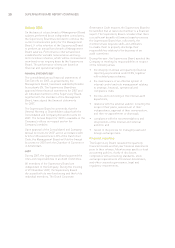TomTom 2007 Annual Report Download - page 26
Download and view the complete annual report
Please find page 26 of the 2007 TomTom annual report below. You can navigate through the pages in the report by either clicking on the pages listed below, or by using the keyword search tool below to find specific information within the annual report.
20 REPORT OF THE MANAGEMENT BOARD (CONTINUED)
“At TomTom, the work of every employee is built around three core
competencies: Open Spirit, Passion for Results and Innovative Thinking.”
The impact of the participation in Tele Atlas on our
balance sheet was significant and shows in the
increase in Non-current assets (+ €817 million)
which includes the investment in Tele Atlas. The
increase in Capital and reserves (+ €450 million)
results from the share issue in December 2007.
Total assets increased by €1,067 million to
€1,970 million.
Balance sheet (in €thousands) 2007 2006
Non-current assets 915,319 59,170
Current assets 1,054,272 843,798
Total assets 1,969,591 902,968
Capital and reserves 1,352,350 550,790
Non current liabilities 42,413 10,982
Current liabilities 574,828 341,196
1,969,591 902,968
ORGANISATION AND HUMAN RESOURCES
ORGANISATIONAL GROWTH
2007 saw TomTom grow by 63.4% to 1,337 employees
worldwide by year-end, from 818 at the end of 2006.
During the year we opened new operations in
Austria, Denmark, Finland, Japan and New
Zealand, and substantially increased our headcount
in Australia, Germany, Portugal, Spain, Sweden,
Taiwan and the US. Wealso successfully integrated
90 new employees who joined the workforce from
Siemens VDO in June 2007.
HUMAN RESOURCES POLICY
Organisational structure
At TomTom, the human resources function is
organised centrally. In principle, all our staff
worldwide areserviced by the Human Resources
department based in Amsterdam. However, there
are also dedicated Human Resources staff in the
US and Taiwan; while our London, Paris, Leipzig
and North Ryde (Australia) sites each have staff
who combine human resources work with other
functions.
Competencies
The work of every employee is built around three
core competencies: Open Spirit, Passion for
Results and Innovative Thinking. These core
competencies, combined with role-specific
competencies, are at the heart of TomTom’s Human
Resources strategy. They are used as the basis for
recruiting, training, developing and compensating
employees, and form the backbone of the General
Performance Scheme (GPS), our performance
appraisal scheme.
General PerformanceScheme
GPS was successfullyintroduced in 2007, with a
comprehensive training programme for managers
and staff alike, along with the development of a
range of largely web-based support tools. Like
GPS, the core competencies were also successfully
embedded during 2007, and both have now become
an integral part of the TomTom spirit and work
culture.
RECRUITMENT
During 2007, TomTom was recruiting 70 new
employees per month. To ensure quality standards
were maintained, a new recruitment process was
developed and implemented, in which we have
embedded the ‘Talentlink’ recruitment system to
ensure fairness and consistency, and to provide
feedback opportunities.
Through a search process that includes our
company website, international job boards,
advertisements, fairs and specialised agencies,
TomTom was in 2007 able to attract a large number
of highlymotivated and talented young
professionals from all over the world.
The three core competencies, combined with the
role-specific competencies, form the basis of our
selection process. In 2007, all managers and
recruiters were offered competency-based
interviewing training to help them select the best
candidates.
























